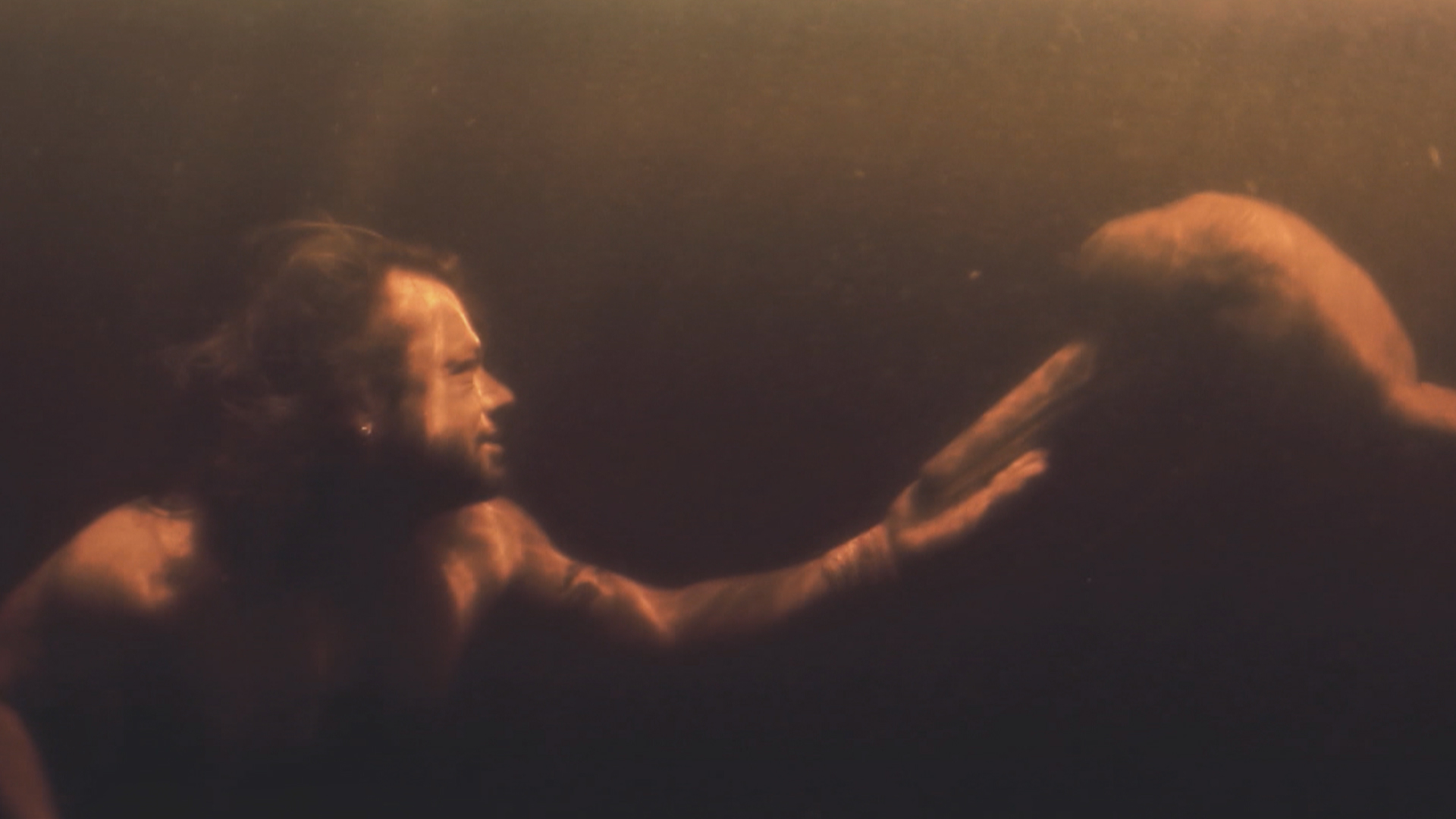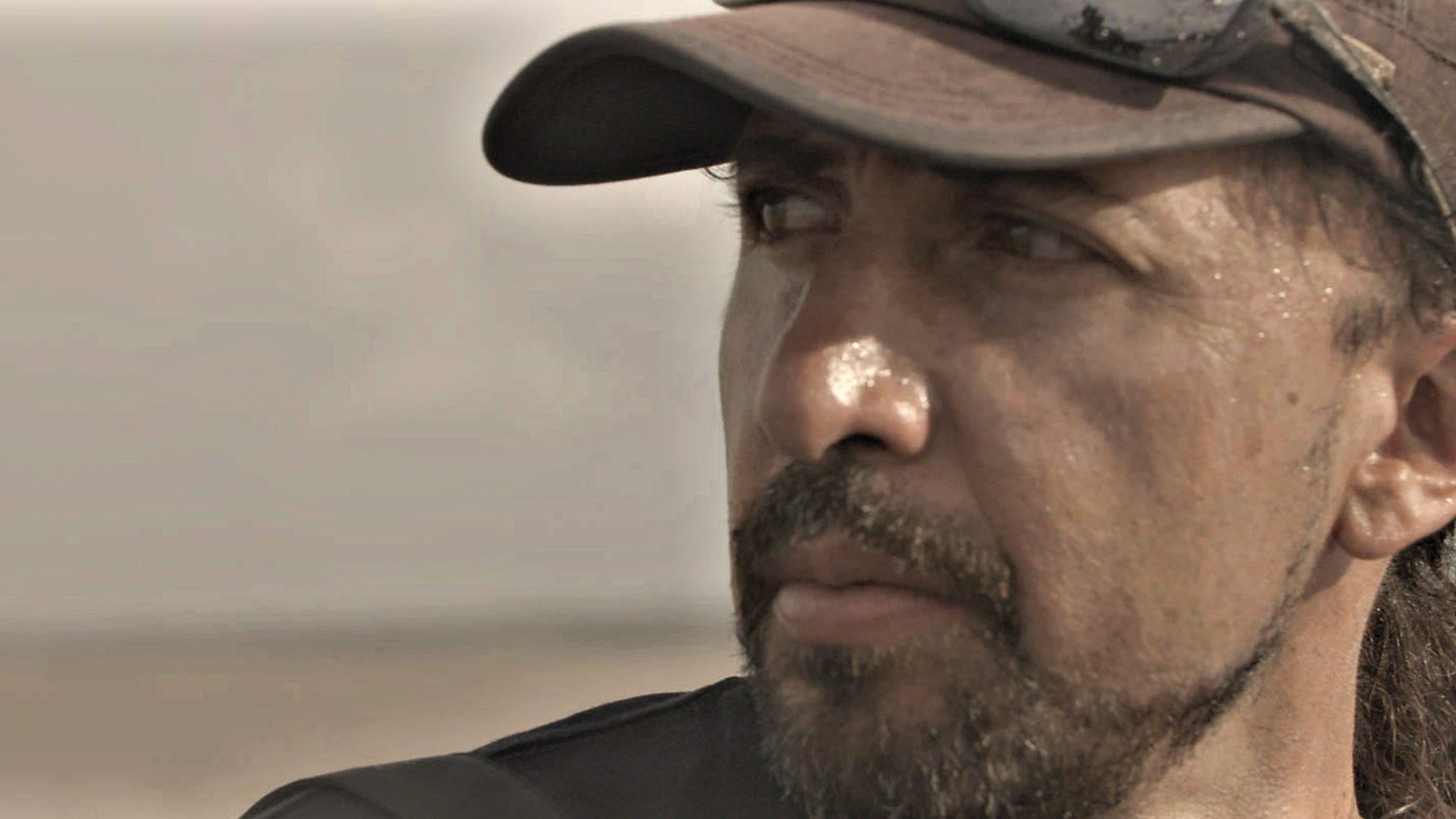Early on in Mark Grieco‘s documentary A River Below, audiences are treated to a nighttime scene where a handful of fishermen along the Amazon spear and capture a pink dolphin. It’s a gruesome and appalling moment. We then see how these same men, in the light of day, chop up the dolphin and throw its meat into the river where it attracts the fish that keep their business afloat. It’s as perfect an encapsulation of why this graceful species is facing extinction and why it’s important to curb their capture in the fishing communities throughout the Amazon river.
Except there’s more. The footage had been shown on Brazilian TV (on Globo’s Fantástico) and had sparked quite the controversy, setting into motion the kind of conservationist laws in that country people like Colombian Fernando Trujillo, Scientific Director of Foundation Omacha and one of A River Below‘s subjects, had been fighting for his entire career. Grieco, the director, became curious: who had captured that footage and how had it been shown for all to see? The surprising answer comes in the form of the doc’s other subject, Richard Rasmussen – Brazil’s version of Bear Grylls – whose connection to the footage becomes one of the many stories A River Below tells. As A River Below follows these various characters, audiences are treated to both an eco-thriller with plenty of twists and turns, and a probing rebuttal to a world full of alternative facts. Filled with sumptuous scenes set in the Amazon and plenty of footage of its changing ecosystem, the film is a perfect example of how conservationist activism is both helped and hampered by our media-saturated environment.
The already explosive documentary has begun causing furor in Brazil. After its world premiere at the Tribeca Film Festival, Brazilian media began circulating headlines that claimed Grieco’s documentary accused Rasmussen and Globo of having paid to kill the dolphin in the footage that’s at the heart of A River Below. This has forced both parties to rebut these claims (which themselves are discussed in the film itself) and prompted Grieco to release his own statement back in May urging everyone to withhold pronouncements based on reviews out of a film festival:
“I categorically deny the allegation that my documentary accuses Richard Rasmussen of paying to kill, or to kill a dolphin. This is clearly false and absolutely not what the film and our staff have stated or believe. Without having watched the documentary, it is irresponsible and perhaps dangerous for the lives of the people who participated in it to divulge this sensationalist claim. My producers and I take great care to tell Richard’s story, the fisherman’s story, and the terrible situation of the Amazonian pink dolphin. We have portrayed several sides of the story in a balanced way, which allows the characters to tell their versions in their own words. Our film raises great questions, but I let the public and the press make their own conclusions, only after watching the film.”
Following its Tribeca bow, Remezcla Film Editor Vanessa Erazo sat down with Grieco where he actually anticipated many of these questions, knowing that the film’s treatment of Rasmussen would be one viewers and critics would likely grab onto. They talked about the origins of the project, why Richard’s charisma made the film all the more dangerous, and why the camera can be a weapon. Check out some highlights below.
On Not Wanting to Make a “Save the Dolphins” Doc
What I attempted to do with the way the narrative works in the film is reflective of how I found the story. So I kind of followed a similar path. I started off with Fernando. He really was our guide to get into this story. I definitely did not want to make the “Save the Dolphin” film. I was worried about making a film about dolphins, but after meeting Fernando I knew there’s got to be something else. And he’s just living an incredible moment in his life. We started with that. And some of the first images in the film are some of the first things we shot. And that’s with him, telling us that this is a problem. Then it kind of unfolded in a bit of really kind of fortunate way for me. I could not believe the turn of events and how things just worked. The one difference chronologically is that we had found and eventually got into that little fishing community where this video was filmed before we met Richard. And that’s because we had to go there and verify the truth behind it; can we trust these people? Are they telling the truth? We wanted to be very cautious about them revealing themselves to us. Because it’s a federal crime to kill the dolphins. And they’d already gotten death threats because people already knew who they were from this video.
On the Brutal Footage of a Dolphin Killing That Complicated the Story
I started to be suspicious of this video almost right out of the gates. I started filming with Fernando and then we went to the Brazilian Amazon to follow the story there, and I had fisherman telling me “Something is wrong. You should look into that video.” To me, it was unbelievable. This footage is done really well. It’s shot professionally. As a filmmaker, I could sense that there’s something going on, an agreement between the people killing the dolphins and the people shooting the film. Because there’s just no sense of tension between them. It seems like “We’re doing this together”—in my mind. That was my first takeaway when I saw it. And I thought it was unbelievable, to me, that in Brazil this was shown on one of the most popular TV shows on a Sunday night. Absolutely brutal footage. And secondly, that no one in Brazil questioned it. My gut reaction was, “How did they shoot it?”

On Questioning the Very Nature of Documentary Filmmaking
“What does it take to get a story? What is the nature of getting that story? Of getting certain images of camera?”
My producer, Torus Tammer, and I knew we could not trick [Richard] entirely in terms of saying “We know nothing. And we just want to interview you, and that’s it.” We asked him about the video straight up. But in a way that did not reveal that we knew something more. We were curious. He trusted us. And this is part of the meta-story of this film is that at a time when I was also questioning myself as a filmmaker and documentary filmmaking itself, I found a story in which I could explore those ideas. What does it take to get a story? What is the nature of getting that story? Of getting certain images of camera? Of having a character really come to grips with a very difficult and frustrating thing in front of the camera, with me? And so what I had to do was what he also did to the village. And that was, I had to conceal what I knew. In fact, in one of those most traumatic moments of our filming with him, he attacks me. Not physically. But he goes right at in the interview and he says, “What you’re doing to me, I did to them.” And so I have no problem putting myself out there because if I’m questioning the actions of somebody in terms of how they got a story and the truth behind these images. Then myself, as the filmmaker, should also be suspect.
On Seeing the Camera as a Weapon
As soon as I realized this had become somewhat of a media study, digging into this story about what is behind the frame of these images—what is it? what was the production behind it?—I started to become very uncomfortable that I was making a film about this and I’m not questioning myself. But I didn’t know how to enter in. I don’t like being in front of the camera. I’m very uncomfortable. But, again, the film gods, kind of parted the clouds and the sun shone down on us at that moment where we were approaching the very town where this was filmed. A place with no running water, no electricity, no cell phone signals, and several of the fisherman are on the bank of the river, filming us with their cell phones. And I knew I had to get that footage from them. And that’s where I enter the film, in a subtle way. I asked them later, why are you filming me? And they say, we’ve been harmed by the camera before and now we can use it to harm anyone else who comes here. So the camera is a weapon.
At one point Richard, who is clearly always in control of his persona and his presence in front of the camera, is now in something that he is not in control of. And that’s when we get at the heart of Richard. That’s where I really wanted this to go. That’s why I won’t shy away from the fact that an interview in a documentary can have a violent tension and relationship between the interviewer and the interviewee. I thought it was my responsibility to also allow him to attack me and judge me for doing those things.

On Structuring the Film Around Two Entirely Different Characters
This is why it was a hard film to edit. It was a really hard film to film. It was a really hard film to show. I’m just now starting to get my legs talking about it. It’s been difficult to understand what this is going to mean to audiences. You have on the one hand a character who is just an innate character in front of the camera. Super charismatic. And our other character is the complete opposite. He’s a consummate scientist, who just wants to go out there and do good work. And they couldn’t be more different in their personalities and the way they approach the work. But their goals are the same. And that is: to stop the dolphin and stop the extinction of certain species. So, of course, Fernando is conflicted and Richard is too. But Richard says something very powerful. He says, “Look, this changed the law. It’s the best thing I’ve ever done for wildlife protection in my life. Forget my TV show. This is the thing. And it was a sacrifice. A sacrifice with a purpose.” When we brought Fernando with that town, he came face to face with how complex conservation can be. It is not just about the animal itself.
On What Grieco Personally Thinks About the Issue
I’m really conflicted myself. I hope this doesn’t hurt Richard. I hope this doesn’t hurt the advocacy for the dolphins. I hope this doesn’t hurt the town or Fernando. I hope that what happens is, by way of not giving that answer, or not clearly showing the audience where my judgments lie, that those audience members will go home and think about this for days.







